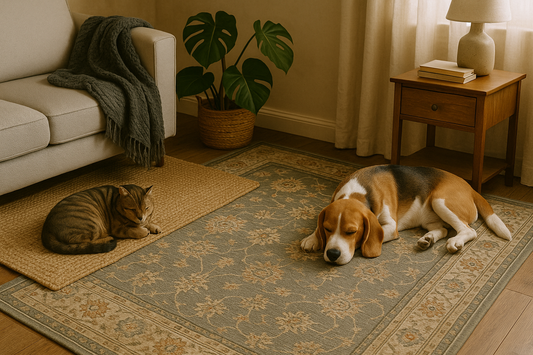Rugs have always been a staple in home décor, but in recent years, designers have embraced a stylish technique that elevates them to a new level—layering rugs. By stacking textures, colors, and patterns, you can create a look that feels curated, cozy, and uniquely yours. At USTIDE, we believe that layering rugs is an art form that allows you to express your personal style while transforming any room into a designer-inspired space.
Why Layer Rugs?
Layering rugs isn’t just about aesthetics—it also brings practical benefits:
-
Adds Dimension: Different textures and heights create visual interest.
-
Boosts Comfort: Extra layers make floors softer and warmer.
-
Defines Spaces: Perfect for open layouts where you want to distinguish living zones.
-
Protects Surfaces: A decorative rug layered over a durable base adds style while protecting delicate fibers.
1. Start with a Strong Base
The first rug in your layering design acts as the foundation. This base rug should be large enough to anchor your furniture arrangement and set the tone of the space.
Good base choices include:
-
Natural fiber rugs (jute, sisal, seagrass) for texture and neutrality.
-
Flatweave rugs that are thin and durable.
-
Solid or muted tones that allow the top rug to shine.
2. Add Personality with the Top Rug
Your second layer is where the fun begins. Smaller than the base, the top rug is your chance to introduce color, pattern, or texture.
Examples include:
-
A vintage Persian rug for timeless character.
-
A geometric patterned rug for modern flair.
-
A sheepskin or shag rug for a cozy, plush feel.
-
A bold accent rug angled for an eclectic touch.
3. Mix Patterns and Colors with Confidence
Designers often mix prints, and rugs are no exception. To avoid clashing, follow these tips:
-
Pair a neutral base with a patterned rug on top.
-
Stick to a cohesive color palette for harmony.
-
Mix large-scale patterns with small-scale designs to create balance.

4. Play with Texture
Texture is one of the most powerful tools in rug layering. Combining smooth and nubby, matte and plush creates an inviting, tactile look.
-
Try a jute rug under a soft wool rug.
-
Place a flatweave rug beneath a tufted or knotted rug.
-
Use a high-low pile rug to add depth.
5. Master Placement
The placement of your layered rugs can completely change the vibe of a room:
-
Centered layering: Perfect for symmetry and balance.
-
Angled layering: Creates a relaxed, eclectic effect.
-
Offset layering: Lets one rug peek out more, highlighting its design.
6. Room-by-Room Layering Tips
-
Living Room: Anchor with a large neutral rug, then add a patterned or colorful rug under the coffee table.
-
Bedroom: Place a large rug under the bed, then layer a smaller one at the foot or angle it for interest.
-
Dining Room: Use a durable base rug under the table, then top with a smaller decorative rug for definition.
-
Hallway: Stack runners for an unexpected layered effect.
7. Avoid Common Mistakes
While layering is creative, a few missteps can make it look messy:
-
Don’t use rugs that are too close in size—there should be visible contrast.
-
Avoid too many bold patterns clashing with each other.
-
Make sure rugs are anchored by furniture or rug pads to prevent slipping.
Final Thoughts
Layering rugs is an art that brings comfort, character, and personality to your home. By mixing sizes, textures, and styles, you can achieve a look that feels intentional and elevated—just like a designer would create.
At USTIDE, we design rugs that blend quality, beauty, and versatility, making them perfect for layering. Whether your style leans modern, bohemian, or classic, layering rugs is a simple yet impactful way to refresh your home and showcase your unique design story.




